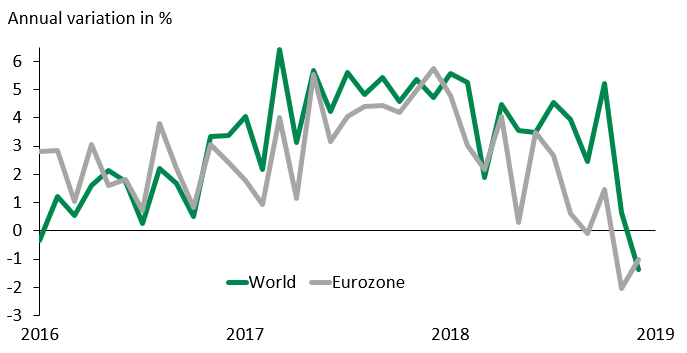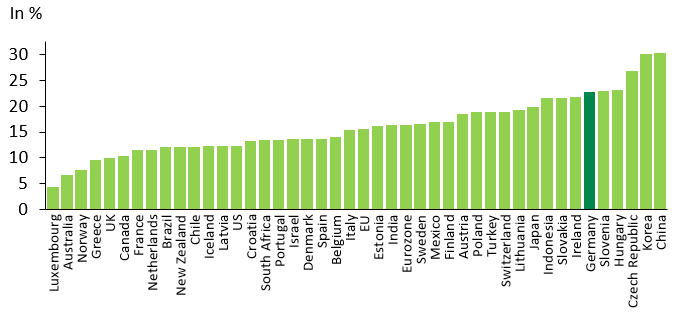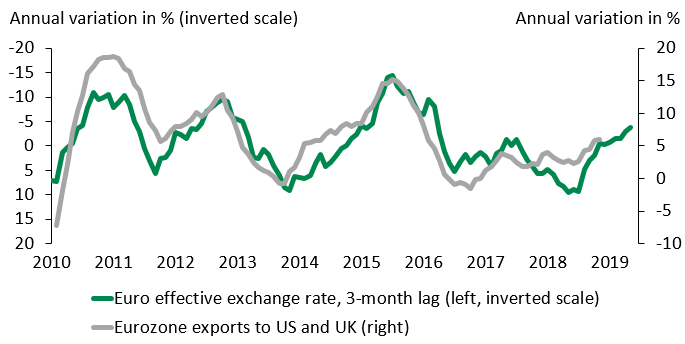All eyes on the eurozone
All eyes on the eurozone
In 2017, the eurozone’s real GDP posted annual growth of 2.5%, the healthiest increase since 2007. But things certainly changed in 2018. Beginning early in the year, economic results failed to meet expectations. These poor indicators were eventually reflected in the eurozone’s real GDP growth, and the year ended with annual real GDP growth of 1.8% higher than it might have been without help from growth in late 2017.
What caused the recent slowdown in the eurozone?
The European economy lost traction at the same time as international trade slowed down. In 2017, international trade posted its strongest annual growth since 2011. However, it has been declining fairly steadily since then, even posting negative annual changes at the end of 2018. Eurozone trade also deteriorated at the same time.
Graph 1 – International trade slowed in 2018, including in the eurozone

Sources: CPB – Netherlands Bureau for Economic Policy Analysis; Desjardins Economic Studies
Interestingly, the loss of traction in the eurozone is due to both external and internal trade. There are several factors behind the weakening of external trade. Both US protectionism and the European Union’s reprisals likely put a brake on trade between the two partners. Eurozone exports to other countries also slowed down. This is the case for China, where the gradual slowdown seems to have affected its trade with Europe. Exports to emerging Eastern European countries also declined.
The value of the euro was another contributor to the slowdown of exports. Thanks to the positive economic situation in Europe, the currency appreciated 9.0% from winter 2017 to winter 2018. In March of last year, it reached its highest peak since summer 2014. That increase made eurozone businesses less competitive.
Much of the recent slowdown in intra-eurozone trade is due to the difficulties facing certain industries. It’s been hard for the automobile sector to adjust to new, stricter environmental rules. The whole value chain issue also tends to undermine internal trade when demand is lower, especially since industrial integration is more important in Europe than elsewhere.
Internal trade was also negatively affected by weak domestic demand in some eurozone countries. Final consumption growth was lower in 8 of the 19 eurozone countries (representing 75.8% of the eurozone) in 2018. The most serious declines were in Germany and Italy.
The problems with Germany’s industries
Germany’s economic problems stem from its status as Europe’s manufacturing giant. It should be noted that Germany is still very focused on manufacturing. In terms of added value for the national economy, only Korea’s manufacturing sector exceeds Germany’s among developed countries (graph 2). This bias toward manufacturing also makes the German economy turn outward, with exports accounting for 45.0% of its GDP (the OECD average is 28.2%). However, Germany’s unique situation makes it more sensitive to the vagaries of the global economic situation.
Graph 2 – The manufacturing sector is particularly important for Germany

EU: European Union
Sources: Organisation for Economic Co-operation and Development; Desjardins Economic Studies
This is especially true in the automobile sector. Some 20% of German manufacturing is dedicated to automobiles. In 2017, Germany produced 5.5 million passenger vehicles, making it by far the largest manufacturer in Europe. (Spain ranked second with 2.3 million units.) The scandal over environmental tests for diesel-fuelled vehicles was a major blow to the German automobile industry. However, the automobile sector isn’t the only source of problems, and other industries have also had issues.
Confidence and political factors
Among the factors affecting the eurozone economy were several elements that may have chipped away at confidence, including some of a political nature.
In Italy, the general election on March 4, 2018, brought in a right-wing/populist coalition that’s having a hard time working together.
In France, there’s some dissatisfaction with Emmanuel Macron’s centrist government. That sentiment has come to a head with the “gilets jaunes” crisis.
Germany’s political situation is also uncertain. Chancellor Angela Merkel confirmed that this would be her last term. Debates surrounding immigration and the country’s current economic difficulties are fuelling political resentment.
Uncertainty about Brexit is also a disruptive element as the eurozone’s main trading partner tries to leave the EU.
Could things get even worse?
It’s clear that the current economic situation in the eurozone is fragile. Several indicators continue to point downward. However, even those less-than-stellar signs paint a more positive picture than during the recessions of 2008–2009 and 2011–2013. Household and business confidence is low, but it’s still far from what it was during both those periods.
One of the factors that has hurt the European economy was the aforementioned rise in the euro’s value. Now, the common currency has depreciated in recent quarters. The euro’s slide could boost exports, especially to the United Kingdom and the United States, the EU’s major trading partners.
Graph 3 – The euro’s decline should soon help exports

Sources: European Central Bank; Eurostat; Desjardins Economic Studies
Of course, Brexit could be a game-changer, especially if the United Kingdom has to leave without an agreement when the current delay expires. At the same time, new protectionist measures from the Trump administration could hurt European trade. Lastly, a more marked slowdown in the Chinese economy could also cause problems for the eurozone economy.
Not much room to manoeuvre if the situation deteriorates
If the risks increase and start to seriously undermine economic activity, it will be interesting to see what the political and monetary authorities are able to do about it.
The European Central Bank (ECB) has practically no more room to manoeuvre. It never managed to begin normalizing its monetary policy, so key rates have stayed way down, in negative territory. It would be difficult to lower them any further, and doing so could upset the money market and savings. Even resorting to new quantitative measures to boost its balance sheet could be complicated, unless the ECB’s operating rules are changed.
Changes to fiscal policy might help improve the economic situation in Europe, but fears of a return to the sovereign debt crisis of the early 2010’s could give politicians cold feet. The main lifeline could come from Germany, where budgetary surpluses have been accumulating since 2014 and government debt as a proportion of GDP has remained one of the lowest of the advanced countries.
Sources:
This link will open in a new tab. https://www.desjardins.com/ressources/pdf/pv190328-e.pdf
